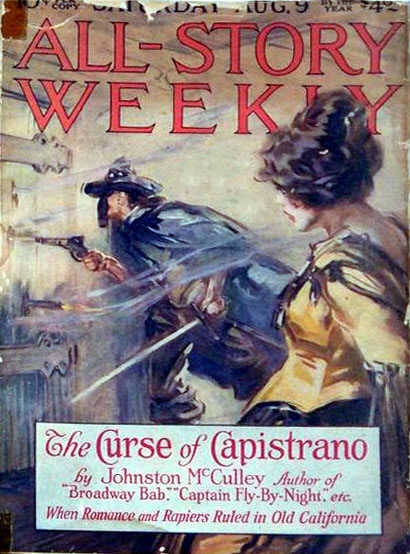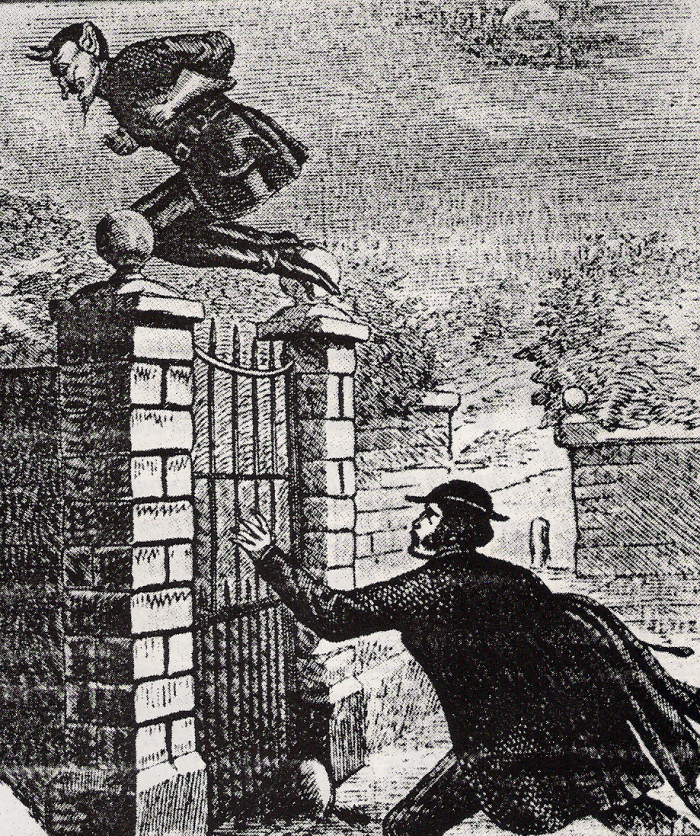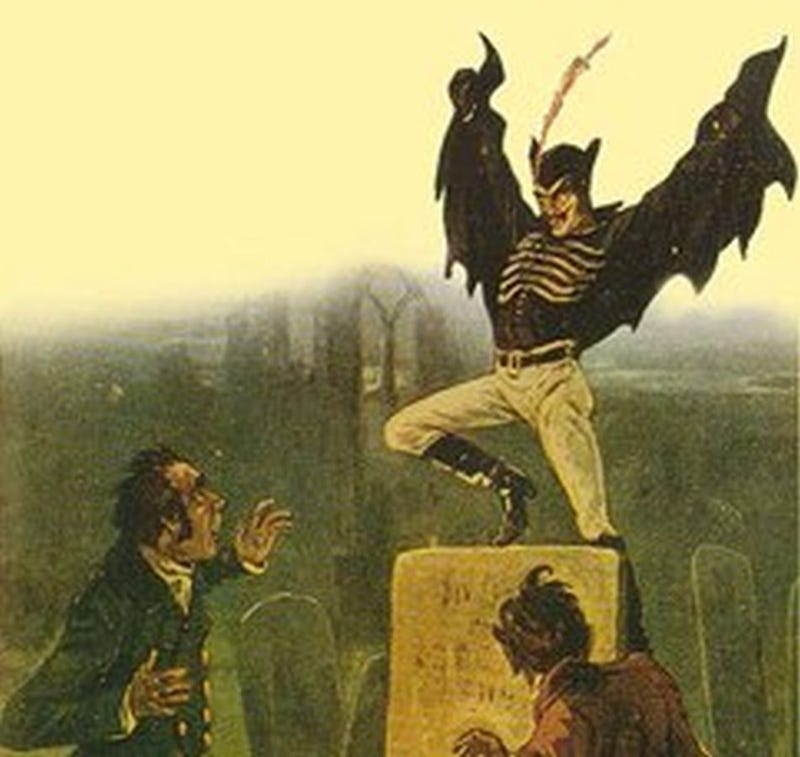This illustration from the Illustrated Police News of 18 November 1926 shows the unfortunate aftermath of an attempted “ghost hoax”:

This illustration from the Illustrated Police News of 18 November 1926 shows the unfortunate aftermath of an attempted “ghost hoax”:

 This historic antique wood engraving, titled “The Capture of a Spirit – Sketches at a Recent Spiritualistic Seance,” represents the dramatic exposure of a fake spirit medium named Florence Cook (1856-1904).
This historic antique wood engraving, titled “The Capture of a Spirit – Sketches at a Recent Spiritualistic Seance,” represents the dramatic exposure of a fake spirit medium named Florence Cook (1856-1904).
During the first heyday of Spiritualism, Cook became one of the its most famous practitioners. She was noted for her purported ability to produce full-form spirit materializations of “Marie,” her spirit guide. During a seance, Marie would step out of the “spirit cabinet,” often singing and dancing to the delight of clients.
At a materialization seance in 1880, one of the attendees, Sir George Sitwell, reached into the spirit cabinet and grabbed Marie. When the lights came up, Marie was found to be Florence Cook, clad only in her corsets and petticoat and wrapped in white drapery.
A classic case of “pay no attention to the woman behind the curtain” …

This unusual book is an anthology, not of “ghost stories” in the usual sense, but rather of “ghost exposure” stories; mysteries in which each appearently supernatural event is revealed to be the product of innocent mistaken identity or mischievous trickery.
Here follows the introduction by the anonymous, skeptical author/compiler (who is often mistakenly identified as F.O.C. Darley – Darley was actually the illustrator).
What is a ghost? In the popular acceptation of the term, it is a visible appearance of a deceased person. It is called also a spirit; but, if visible, it must be matter; consequently not a spirit. If it is not matter, it can only exist in the imagination of the beholder; and must therefore be classed with the multifarious phantoms which haunt the sick man’s couch in delirium.
But ghosts have appeared to more than one person at a time;—how then? Can he exist in the imagination of two persons at once? That is not probable, and we doubt the ” authentic” accounts of ghosts appearing to more than one at a time. The stories we are about to tell will show, however, that in a great many instances several persons have thought that they saw ghosts at the same time, when, in fact, there was no ghost in the case; but substantial flesh and blood and bones.
(…)
But to cut the matter short—the whole theory of ghosts is too flimsy to bear the rough handling of either reason or ridicule. The best way to dissipate the inbred horror of supernatural phantoms, which almost all persons derive from nursery tales or other sources of causeless terror in early life, is to show by example how possible it is to impress upon ignorant or credulous persons the firm belief that they behold a ghost, when in point of fact no ghost is there. We proceed at once to our stories.
We here at The Ghost Racket tend to agree with this thesis.
If you’d like to read these non-ghost stories, the anthology is freely available here.


Edwardian-social-issue-of-the-week: mass hysteria
“Supernatural” crime: Spring Heeled Jack attacks!
Cards on the table; we here at The Ghost Racket are massive, long-term Spring Heeled Jack fans and we’ve been eagerly anticipating Houdini and Doyle’s take on London’s “leaping ghost” for many months. How does it compare to the frustrating SHJ storyline in the 2015 Jekyll and Hyde series? Read on …
Episode 4 opens, curiously, with a newsboy hawking the latest London buzz; automotive omnibuses are soon to replace the good old horse-drawn variety. Automobile magnate Barrett Underhill should be on top of the world, but instead he’s perturbed by a sinister note quoting Moby Dick, which is slipped under the door of his 7th-floor hotel room:
From Hell’s heart, I stab at thee!
Later that night, Underhill is roused by strange flutterings and scratchings at his window. Investigating, he opens the window and gazes out over the London roofscape – but then, just as he glances upward, a demonic, bat-like figure hurls itself at him from above, sending him plummeting to his death!
The next morning Constable Stratton summons Houdini and Doyle, and they learn that the hotel doorman spotted an uncanny winged figure leaping or flying from the roof moments after Underhill fell. Houdini, scoffing at the suggestion that a demon might have been to blame, leaps to the conclusion that it was simple misadventure; the startled doorman, Houdini suggests, mistakenly associated the coincidental overhead flight of a large bird with the man’s accidental, or perhaps suicidal, death. Stratton and Doyle aren’t so sure – after all, Underhill was just about to make a great deal of money from the automotive omnibus deal, and had also just received an overtly threatening, anonymous note.
Stratton, meanwhile, receives a mysterious telegram and temporarily excuses herself from the case, claiming illness.
Investigating Underhill’s business rivals leads Houdini and Doyle straight into a confrontation with a Mr. Tuttle, the owner of London’s largest horse-drawn bus company. Tuttle is a surly man who seems to have had both motive and method for murder. Doyle, however, pursues the supernatural angle and notes that the hotel doorman’s description, and the circumstances of Underhill’s death, are highly reminiscent of the legend of Spring Heeled Jack. Just then the two amateur detectives encounter Lyman Biggs, a cheerily verbose tabloid newspaper reporter who decides the “leaping demon” angle is far too good to pass up.
Shortly thereafter, a slumlord is pursued through the back alleys by an agile, shadowy, blue-fire-breathing phantom. The landlord’s body is found the next morning, gruesomely impaled on the railings of a high fence. Then Jack strikes again, smashing through the window of a wealthy Russian woman’s apartment and slashing at her with his claws before leaping off into the night.
Within days, London is paralysed by the fear that Spring Heeled Jack has returned. Doyle notes darkly that his reappearance has always betokened some great disaster, while Houdini takes the opportunity to demonstrate how easily mass hysteria can be conjured by briefly convincing a roomful of people that they’re endangered by an invisible gas.
Arthur Conan Doyle’s family is swept up in the general Spring Heeled Jack panic, as his young son Kingsley becomes tearfully convinced that Jack is stalking him; Doyle seems unable to comfort the boy beyond telling him to keep a stiff upper lip.
Houdini, Doyle and Stratton are eventually able to eliminate Mr. Tuttle as a suspect – he did write the threatening note, but cannot have committed the Spring Heeled Jack attacks. Pursuing a lead offered by the Russian woman, the trail then leads to a circus acrobat, Vladimir Palinov, who was both a jilted suitor of the woman’s and a recently evicted tenant of the landlord’s, but who seems to have had no connection to Underhill the automobile magnate.
That night, Lyman Biggs, the journalist, is confronted by Spring Heeled Jack, who drops from the shadows above; but Biggs quickly recovers his composure and berates the costumed figure before him for “nearly giving the game away”. “Jack” then pulls off his mask to reveal the face of Harry Houdini; as it turns out, Palinov the acrobat confessed that Biggs had hired him to impersonate Spring Heeled Jack in order to “goose the story” and sell more papers. Biggs himself, therefore, has accidentally just admitted to orchestrating the plot to the disguised Houdini.
Later, however, while being interviewed in prison, Biggs claims that the slumlord’s death was a tragic accident. Palinov had only been trying to scare him, and the panicked victim had slipped and impaled himself on the railings while trying to escape. Biggs also insists that he had nothing to do with the attack on Barrett Underhill, and, in fact, that he had never even heard of Spring Heeled Jack until he overheard Doyle describing the demon to Houdini. At that point, he conceived the plan to bring the legend to life, so as to profit by fear-mongering through his newspaper stories.
In the final shot, a mysterious, dark figure is watching Houdini and Doyle from the rooftops …
Observations:
There’s a very strong scene in which Houdini and Doyle debate the nature of fear and the best way to deal with it; Houdini, fulfilling his role as the brasher, more outwardly emotional of the two, urges Arthur to admit his terror, telling him that this is the only way it will lose its power over him. Arthur is then, in a rather touching interlude, able to tell his son that it’s all right to be afraid.
Jack’s acrobatics are also very pleasingly handled – it’s a good bet that a parkour-trained stuntman executed his street gymnastics of vaulting and side-flipping over walls, etc. Dynamic stuff and, again, just what we were hoping for in watching Spring Heeled Jack in action.
RATING:
Nine ibangs out of ten for our favourite episode so far! Plenty of action and mystery, some welcome character development and the whole thing moves along at a cracking pace.

The history of shadowy pop-fiction vigilantes is … well … shadowy, and answering the question “who was first?” requires some careful caveats.
This article is specifically an attempt to trace the lineage of those quasi/proto-superheroes who are literally masked and who assume a supernaturally-themed alternate identity to “strike fear into the hearts of evildoers”. Many of them are also aristocrats in their “everyday” lives. Therefore, I’m discounting the very long tradition of culture heroes (Gilgamesh, Hercules, Beowulf, et al), super-powered or otherwise, who don’t bother with actual secret identities in the comic book sense.
Robin Hood comes very close to being the trope originator, but I’d argue that he didn’t maintain a dual identity so much as simply adopt a new name (and, obviously, lifestyle); likewise, his motif was more “altruistic outlaw” than “supernatural avenger”.
It’s commonly accepted that the masked avenger trope popularized in comic books during the 1940s was directly inspired by ’30s pulp fiction “mystery men” such as the Lone Ranger, the Shadow and the Phantom, with occasional glances further back to Baroness Orczy’s Scarlet Pimpernel (circa 1904) – who is discounted here because, although an expert in disguise, he did not have a distinctive, masked alter ego. Johnston McCulley’s Zorro, who premiered in The Curse of Capistrano (1919), certainly does qualify, and he is often justly cited as a direct precursor of the masked, shadowy vigilante pulp heroes of the ’30s.

However, Zorro himself had at least two predecessors, relatively little-known today, who had also manifested the “supernatural avenger” mystique.
1915 saw the first appearance of British author Russell Thorndike’s character, Dr. Christopher Syn, alias the Scarecrow. Doctor Syn: A Tale of the Romney Marsh was set in the coastal English village of Dymchurch during the 18th century, at a time when the villagers could only sustain themselves through smuggling. Dr. Syn – who was formerly and secretly a feared pirate known as Captain Clegg, and currently the apparently meek and mild village parson – assumes a third identity, that of the masked, demonic Scarecrow, to protect his parishioners from the King’s Revenue Men.

The Scarecrow was an expert strategist, rider, fencer and marksman, whose intimidating mask, costume and shrieking laugh instilled fear into his enemies. His sidekick, Mr. Mipps, also assumed a secret identity (as the skull-masked Hellspite) and they were headquartered in a hidden barn on the outskirts of Dymchurch.
Thorndike wrote a series of subsequent novels – actually prequels to Doctor Syn – and the series was later adapted into several movies, including three classic Disney tele-films starring Patrick McGoohan as Dr. Syn/the Scarecrow:
Appearing decades even before the Scarecrow, however, the mysterious Spring Heeled Jack may very well be the actual originator of many “masked avenger” tropes.

Stories of Spring Heeled Jack had first emerged during the 1830s. Confused London newspaper reports melded with rumor and gossip to conjure something approaching mass hysteria concerning this very strange figure, who was said to possess supernatural agility, to be able to spit blue and white flames and to be armed with steel claws. This early, folkloric rendition of Jack was an amorphous figure, sometimes said to be the devil in more-or-less human form; an acrobatic boogeyman who seemed to delight in leaping out from the shadows and molesting young women.
There is no doubt that Spring Heeled Jack became the most famous exemplar of the curious 19th century “playing the ghost” or “ghost act” craze, which was widely reported upon in newspapers at the time. “Ghost actors”, according to these reports, would dress in outlandish costumes and, thus disguised, would startle or even assault passers-by before vanishing back into the night (or, occasionally, being shot or beaten by their would-be victims).
Over a number of decades, though, actual (fearful) belief in Spring Heeled Jack gave way to nostalgia and whimsy. By the mid-19th century he was being featured as a villain in novels and plays, including a famous production mounted by the acrobat/actor/impresario George Conquest.
By the 1880s Jack was beginning to be portrayed as an anti-hero – though often drawn and described as resembling a monstrous man/bat/lion hybrid, springing about the streets and rooftops of London. It then required only a short leap (!) of the imagination to transform him into an outright hero.

Several circa 1900 “penny dreadful” iterations of Spring Heeled Jack, including many stories written by Alfred Burrage under the pseudonym “Charlton Lea”, portrayed Jack as a nobleman who had been cheated out of his inheritance and who took up a devilish disguise to punish those responsible. Along the way, Spring Heeled Jack also rescued damsels in distress and generally stood up for the innocent and downtrodden while terrifying evildoers. He wore a distinctive costume and was capable of performing incredible leaps thanks to a special pair of boots, credited in one tale to a secret mechanism invented by Indian street magicians.
Anticipating Zorro, Spring Heeled Jack was fond of marking both enemies and territory by carving his initial “S” with the point of his rapier. He also maintained a secret underground lair (in a converted crypt) and frightened his adversaries with his ringing laugh and catch-phrase, “The day is yours – leave the night to me!”.
Thus, it may be that, by fully transforming Spring Heeled Jack from an urban ghost story to a heroic “dark avenger”, penny dreadful author Alfred Burrage originated a number of narrative motifs and tropes that influenced subsequent generations of masked, supernaturally-themed vigilantes. By the time comic book heroes such as Batman were created, those motifs had already been further elaborated in pulp novels – most famously by Johnston McCulley’s Zorro character and by Russell Thorndike’s Scarecrow stories – and also in movie serials, to the point that they were part of the pop-literature zeitgeist.
If you can think of an earlier example of this trope, please let us know in the comments!
Note – an earlier version of the above article originally appeared on the Past Tense blog during October of 2014. It is re-used here by permission.